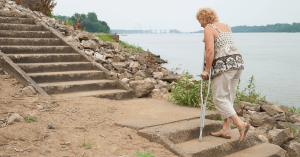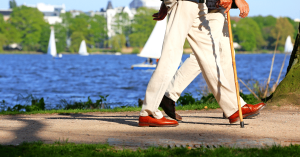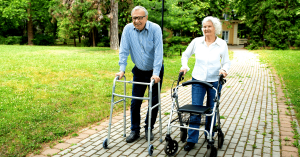
I’ve taught many people how to use a walker over the years – in hospitals, at home and when out and about.
So if you’re thinking about using a walker or already do, check out this guide to find out everything you need to know!
Table of Contents
Toggle1. When to use a walker
So you may be wondering when and why you might need to use a walker in the first place? There are three main reasons for using a walker – restricted weight bearing, leg weakness and balance. See below for details:
a. Restricted weight bearing
If you are not allowed to put full weight through your leg after a fracture or surgery, a walker may help you to get about at home until you are allowed to put weight through your leg again.
A walker may also be suitable if you tried crutches but struggled to walk safely with them [1].
b. Leg weakness
If your legs are weak due to injury or lack of mobility a walker can provide extra support to help you stand and walk [1] without your legs giving way.
c. Balance
2. Types of walkers
OK, first off there are many different names for walkers and many different types of walkers! So let’s get this clear first so you know what you’re dealing with.
Walkers can also be called walking frames, zimmer frames, rollator frames, gutter frames etc.
They can have different numbers of wheels (or none) and can have many extras such as brakes, baskets and sitting benches. They can also be foldable.
Some walkers are designed specifically for outdoor use whilst others are for indoor use only.
There are two main types of walker:
- A standard walker
- An outdoor walker
1. A standard walker
Normally designed for indoor use, a standard walker can be used on hard floors or carpets.
The standard walker is the most stable type of walker, designed to prevent loss of balance and falls.
It is also designed for putting quite a lot of weight through the frame. So this is the type of walker you will be using if you are not allowed to put full weight through your leg.
Or if your legs are weak and you have to put a lot of your weight through your arms.
There are two main types of standard walker, those with wheels and those without:
A standard walker with no wheels:
The walker’s adjustable legs will have four stoppers on the bottom of them.
This walker tends to be helpful for people if they tend to let a walker with wheels get ahead of them. If a walker gets too far in front of you it will not be providing the required support and stability.
The downside of this type of walker is that it has to be lifted off the floor slightly every time you want to take a step. This can be problematic for people with very weak arms.
There will also be a moment of instability when the frame is off the ground, which may not be safe for people who are very unsteady on their feet.

A standard walker with wheels:
This type of standard walker has two wheels at the front and two stoppers at the back. This means the walker can slide forwards as you walk without the need to lift it off the ground.
This can make for a faster, smoother walking pattern. And may be better for some people who get unsteady when lifting a no wheel walker.
With this type of frame you just need to be careful that it doesn’t get too far in front of you when walking.

2. Outdoor walker
Also known as 3 wheeled and 4 wheeled walkers.
Designed for outdoor use, though can be used indoors also.
Not to be used unless you are allowed to put full weight through your legs and don’t need to push down too heavily. This is because they are not designed for heavy weight bearing.
These types of walkers come with brakes and normally a basket or bag to put your things.
4 wheels walkers also sometimes come with a seat if you need to sit down whilst you are out and about.

Gutter frame
This is a less commonly used type of walker but I thought I would mention it anyway in case it is relevant to you.
A gutter frame is a walker with support for the forearms to rest on. It is used if someone needs to use a walker but cannot weight bear through their wrist or hand.
This could be due to, for example, a wrist fracture after a fall – they take the weight through their forearms instead.
A gutter frame often has two wheels at the front and two stoppers at the back.
This frame would normally only be used short term.

For your safety: If your weight bearing is restricted i.e. you have been told you are non weight bearing, partial weight bearing or touch weight bearing, it is not safe to use an outdoor 3 or 4 wheeled walker.
These are not designed to take your body weight. You should only be using a standard walker (or a gutter frame if appropriate).
3. How to measure/adjust your walker
How you measure and adjust your walker will, of course, vary depending on the type of walker and make. So these are just general guidelines for the main types of walkers.
Please consult your walker’s instruction manual for specific details and safety advice.
Standard Walker:
- When standing with your walker with your arm down by your side, the handle of the walker should be roughly level with your wrist.
- When holding onto the walker handles you should have a slight bend in your elbow and your shoulders should be relaxed down away from your ears.
- Adjust the height of the legs by pushing the pin in and then making the legs longer or shorter. Just make sure the pin pops out again so you know you’ve done it properly and the leg won’t collapse on you.
- If it is a foldable walker there will be catches of some sort to fold and unfold it (see the video below).
Outdoor walker:
- When standing with your walker with your arm down by your side, the handle of the walker should be roughly level with your wrist.
- When holding onto the walker handles you should have a slight bend in your elbow and your shoulders should be relaxed down away from your ears.
- Adjust the height of the handles by unscrewing and taking off the bolt and washer, pulling the handle up or down and then replacing the bolt and washer and screwing up again.
- There are normally two ways of using the brakes – pulling up to brake temporarily as you are walking, and then the permanent brake for when you are sitting down on the walker.
Gutter frame:
- The frame is the correct height when you can stand up with your forearms in the gutters, your elbows are at right angles and your shoulders are down away from your ears.
- Adjust the height of the legs by pushing the pin in and then making the legs longer or shorter. Just make sure the pin pops out again so you know you’ve done it properly and the leg won’t collapse on you.
- The angle of the gutters and handles can be adjusted for comfort.
For your safety: Please be careful when measuring your walker, especially if you are unsteady on your feet. Have someone with you to help out or sit in a chair whilst adjusting the walker. And stand with your chair behind you or next to a wall or table just in case.
Also please make sure you check that you have adjusted all the legs of your walker to the same height, otherwise your walker will tip and not be safe.
4. Types of weight bearing
How you use your walker will depend on how much weight (if any) you are allowed to put on your leg.
But how do I know what my weight bearing status is? I hear you ask.
Well, if there is any restriction to how much weight you can put through your leg you would have been told this by a doctor – normally an orthopaedic surgeon if you have had surgery or a fracture.
Full Weight Bearing/Weight bearing as tolerated (FWB/WBAT)
Fully weight bearing (or weight bearing as tolerated) means you are allowed to put as much weight through your leg as you can.
You may be limited by pain but if you can put weight on your leg you should, as it will help with healing and keeping your muscles strong and flexible [4].
Partial Weight Bearing (PWB)
Partial weight bearing means you are only allowed to put some of your weight through your leg, not all of it.
Generally, unless told otherwise, partial weight bearing means 50% weight bearing. So you can put up to half your weight through your leg and the rest needs to go through your walker.
You can stand normally when partial weight bearing because half of your weight is going through your other leg naturally.
It’s only when you start to walk that you have to be careful how you use your walker.
Touch Weight Bearing (TWB)
Touch weight bearing (sometimes called toe touch weight bearing) means you can touch your foot down on the ground very lightly but you are not allowed to put any weight through the leg.
Imagine there is an egg on the ground – you can touch it lightly with your toes but don’t put weight through or you will crack the egg shell.
Or my personal favourite: imagine there is a bumble bee on the ground and you can touch it’s wing very lightly with your toes but don’t squash it!
Touch weight bearing can help you to balance as you can still feel the ground, which can help some people feel more steady when using their walker.
Non Weight Bearing (NWB)
Non weight bearing means you are not allowed to put any weight through the leg at all until you are told otherwise.
This means that your bad/injured leg will be off the ground completely and you will be using your walker and your good leg only to get about.
Putting weight on the leg could affect your legs ability to heal properly after injury/fracture/surgery [5].
5. How to use a walker for walking
The below instructions are for walking with a standard walker, for different weight bearing restrictions.
When walking with a 3 or 4 wheeled walker you can just keep the walker slightly in front of you whilst walking normally.
How to use a walker fully weight bearing (FWB)
- You can stand normally with equal weight through both legs
- Slide or place your walker slightly in front of you (it shouldn’t be so far in front that your elbows are locked out straight).
- Take a step forward with your bad leg so it’s roughly in line with the back stoppers of the walker, putting a bit of weight through the walker if you need to due to pain or discomfort.
- Bring your good leg in line with your bad leg
- Then start over by moving the walker forward again
If the sort of beginner walking shown in the video above is too basic and slow for you there is the option of using a 3 or 4 wheeled walker instead.
This is providing you are fully weight bearing, steady on your feet and can control the walker.
As you can see in the video below, you don’t have to worry so much about which leg goes first, just walk as naturally as you can with the walker.
How to use a walker partially weight bearing (PWB)
- You can stand normally with equal weight through both legs
- Slide or place your walker slightly in front of you (it shouldn’t be so far in front that your elbows are locked out straight).
- Take a step forward with your bad leg so it’s roughly in line with the back stoppers of the walker (put half your weight through the walker so only half your weight is on the leg)
- As you step the good leg forwards make sure you are weight bearing heavily through the walker to take half of the weight off the bad leg
How to use a walker touch weight bearing (TWB)
- Stand with the toes of you injured leg lightly touching the ground only (use your walker to balance)
- Walker forward first
- Bad leg forward (put all your weight through the walker, your toes are touching the ground lightly for balance only)
- No weight on the bad leg (all weight through the walker as you step the good leg forwards)
Top tip: Some people find this hard to get their heads around – if this is you, you might find it easier to just non weight bear instead (see below).
How to use a walker non weight bearing (NWB)
- Stand with your walker with your injured leg off the ground (with your knee bent so your foot is back behind you slightly)
- Move your walker forwards
- Put all your weight through the walker as the good leg hops forwards. Your bad leg stays off the ground and out of the way the whole time.
Top tip: If you don’t feel safe trying to non weight bear with a walker you may benefit from using a wheelchair instead whilst you’re non weight bearing.
6. How to use a walker to turn around
With a standard walker:
To turn around you need to walk around in a circle as your walker can’t turn sharply. This is because even if your walker has wheels at the front, the wheels are fixed in place and can’t turn.
So you will need to walk in a big turning circle, taking plenty of steps around. Make sure you keep all four points of the walker on the floor throughout.
With an outdoor walker:
The wheels on a 3 or 4 wheeled walker can twist and turn so there is more manouvre-ability. This means you can complete tighter turns and don’t have to take so many steps around.
For your safety: If you have had a surgery such as a hip replacement and you have been told not to twist on your leg you need to make sure you pick up your feet and step around in a circle rather than twisting on your leg.
7. How to use a walker to get up and down a curb
The safest thing to do is to try to avoid having to go up and down a curb at all. But if you have no other choice this is how to do it safely:
Getting up a curb:
- Step your walker and your body as close to the curb as you can
- Lift your walker up onto the curb
- Step up onto the curb with your good leg first
- Bring your bad leg up to join it
Getting down a curb:
- Step your walker and your body close to the edge of the curb
- Lower your walker down off the curb
- Step down with your back leg first
- Bring you good leg down to meet it
For your safety: Ideally have someone with you when you attempt this just in case. I also don’t recommend trying this unless you are allowed to put full weight through both legs.
8. What to do about stairs/steps
It is not safe to attempt to use a walker on stairs. This is because the tread of stairs aren’t deep enough to accommodate a walker safely. Your alternative options are:
- Switch to a crutch or cane and hold a rail to get up and down the stairs (You will need two walkers if you are doing this – one for upstairs and one for downstairs). Please only attempt to do this if you feel safe to do so and have someone with you at first.
- Live temporarily downstairs only whilst you are using the walker.
- If you are using a walker long term and option 1 isn’t safe for you and you really want to be able to get upstairs again, your alternative is to consider installing a stair lift of some sort.
9. How to use a walker to stand up and sit down
There’s a certain technique for standing up and sitting down with a walker to ensure you stay safe.
Standing up with a walker:
- Ensure your walker is in front of you
- Shuffle forward in your chair
- Push down with both arms on the arm rests of your chair
- Stand up putting more weight through your good leg if needed
- Hold onto the walker ready for walking
Sitting down with a walker:
- Step carefully backwards until the chair is at the backs of your legs
- Put both your arms down on the arm rests of the chair
- Slowly lower yourself down into the chair
Top tip: Taking backwards steps can be hazardous so try to minimise these as much as possible by walking forwards as close to the chair as you can before turning around so the chair is behind you.
10. Safety tips when using a walker
My top tips for staying safe when using a walker:
- Don’t try to use your walker on the stairs
- Take care not to stand too close to the front crossbar of your walker or you could lose your balance backwards
- Don’t let the frame get too far in front of you if it’s got wheels as it won’t be able to support your properly
- Make sure you keep all four points of your walker on the floor at all times to avoid it tipping
- When using an outdoor walker try to keep your hands loosely on the breaks at all times whilst holding the handles in case you need to stop suddenly
- Keep both hands on the walker handles at all times as your walker can tip sideways if you only have one hand on
- Use a caddy or similar attached to your walker to transport things so you can keep both hands free and on the walker
So there you have it – everything you need to know on how to use a walker like an expert!
I hope this helps you to get around with your walker with greater safety, confidence and peace of mind.
What to do next?
If you haven’t chosen a walker yet, why not take my quiz to help you choose the right one for you:
Discover which walker or rollator is best for you – QUIZ
If you’re not sure whether a walker is the right mobility aid for you, why not check out my other quiz:
Which mobility aid is right for you? – QUIZ
If you are planning on using stairs with a cane or crutches please read my guides on how to do this safely first:
References
[1] Thomas S, Halbert J, Mackintosh S et al 2010 ‘Walking aid use after discharge following hip fracture is rarely reviewed and often inappropriate: an observational study’ Journal of Physiotherapy, vol 56, issue 4, pp 267-272
[2] Bateni, H and Maki B.E 2005 ‘Assistive devices for balance and mobility: benefits, demands, and adverse consequences’. Archives of Physical Medicine and Rehabilitation vol 86, pp 134-45.
[3] Graafmans W.C, Lips P, Wijlhuizen G.J. 2003 ‘Daily physical activity and the use of a walking aid in relation to falls in elderly people’ Zeitschrift für Gerontologie und Geriatrie, Band 36, Heft 1
[4] Anderson, T. B and Duong, H. 2022 [Updated 2022 May 8]. ‘Weight Bearing’. In: StatPearls [Internet]. Treasure Island (FL): StatPearls Publishing
[5] Smeeing, D.P.J., Houwert, R.M., Briet, J.P. et al. 2020 ‘Weight-bearing or non-weight-bearing after surgical treatment of ankle fractures: a multicenter randomized controlled trial’. European Journal of Trauma & Emergency Surgery vol. 46, pp. 121–130









